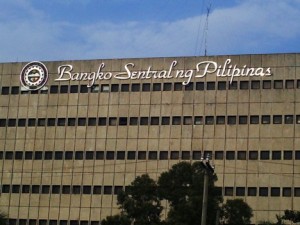
Bangko Sentral ng Pilipinas is expected to slash key interest rates to new record lows within 2012 or as early as this week’s monetary policy meeting, given the trend of global easing to cushion against external economic shocks.
MANILA, Philippines—The Bangko Sentral ng Pilipinas is expected to bring its key interest rate, the overnight borrowing rate, to a record low of 3.75 percent during its policy-rate setting on Thursday given a benign inflation environment and a weak global economic backdrop.
Taking the cue from BSP Governor Amando Tetangco Jr.’s remarks that indicated bias for monetary easing, New York-based think tank Global Source, JP Morgan Chase and Security Bank have projected a cut in the central bank’s overnight borrowing rate, which is already at a low of 4 percent.
However, Singapore-based DBS Group expects the BSP to keep its policy rates unchanged.
“For now, we believe that rate cuts may be premature and the BSP will keep the (overnight borrowing rate) steady at the monetary policy meeting on Thursday,” DBS said in a research note.
DBS Group admits that while rate cuts do not loom large in its radar, there is an increasing chance that the BSP will cut rates in the coming months.
For its part, a Global Source research written by economists Romeo Bernardo and Margarita Debuque said local monetary authorities might take advantage of the low inflation expectations and weak global economic backdrop to cut rates as early as Thursday.
“The reason for the easing would be to further avert speculative play and not to avoid a possible growth slowdown, as some analysts would argue, given that interest rates are already at historically low levels such that investment may no longer be sensitive to further lowering,” Global Source said.
Revising its earlier call for a 25-bp rate cut by September 13, JP Morgan Chase economist Matt Hildebrandt said the cut in the policy rate to a new low of 3.75 percent may happen during the Monetary Board meeting on Thursday, following Tetangco’s remarks that the BSP had “some scope to adjust monetary settings to protect the inflation target on the downside.”
“This is not the first time that the BSP has used this language, but we have to assume that the timing of this message is deliberate. The notable shift in the tone of the text message relates to upside risks from higher utility rates and oil prices, which were downplayed much more than in the past,” Hildebrandt said in a July 24 research note.
With inflation falling below the lower bound of the BSP’s 3-5 percent range in four of the last five months and global economic growth slowing, Hildebrandt said the environment was conducive for a rate cut. “In addition, a rate cut would benefit BSP’s intent to reduce the strengthening pressure on the peso (at least in the near term) and it would reduce sterilization costs,” the economist said.
Security Bank treasurer Rafael Algarra said on Wednesday that a 25-basis point cut was expected. “I think inflation remains relatively low and global economy started to show signs of global weakness. Some regional central banks have loosened rates and with peso relatively strong, that gives it leeway,” he said.
But Algarra expects that the 25-basis point cut on Thursday would be a “one-time” event. “When they were cutting before (early this year), they left space. They just became conservative and left something on the table.”
The BSP slashed its overnight borrowing rate by a total of 50 basis points earlier in the year to 4 percent.
Lower interest rates not only temper borrowing costs but also make peso-denominated assets less attractive in an environment where the BSP is seen in a dilemma on how to curb a sharp peso appreciation against the US dollar.
“Our guess is that monetary authorities have drawn a line in the sand for the peso-dollar rate somewhere near 41 per dollar, which seems to be a sensible number. Economists studying this area believe P40 (and below) to a dollar exchange rate may already be quite harmful to growth,” Global Source said in its report.
Global Source said “hot” money inflows and their impact on the exchange rate would also likely influence the BSP’s monetary stance.
“This is mainly to discourage carry trade, ease exchange rate volatility, and lower the BSP’s sterilization costs,” the report said. “An early signal may have been sent with the recent 3.125-basis point reduction in SDA [special deposit account] rates, reducing the difference versus the RRP (reverse repurchase agreement), and the central bank governor’s dovish remarks,” Global Source said in the research.
The RRP or overnight borrowing and the SDAs are some of the local central bank’s tools to mop up excess liquidity in the financial system.
Originally posted at 05:38 pm | Wednesday, July 25, 2012